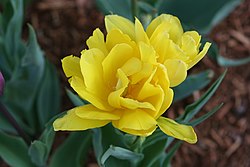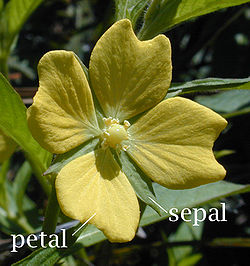Petal

A petal (Greek: leaf, tablet), regarded as a highly modified leaf, is one member or part of the corolla of a flower. The corolla is the name for all of the petals of a flower; the inner perianth whorl, term used when this is not the same in appearance (color, shape) as the outermost whorl (the calyx) and is used to attract pollinators based on its bright color. It is the inner part of the perianth that comprises the sterile parts of a flower and consists of inner and outer tepals. These tepals are usually differentiated into petals and sepals. The term "tepal" is usually applied when the petals and sepals are similar in shape and color. In a "typical" flower the petals are showy and colored and surround the reproductive parts. The number of petals in a flower (see merosity) is indicative of the plant's classification: eudicots (the largest group of dicots) having typically four or five petals and monocots and magnoliids having three, or some multiple of three, petals.[1]
There exists considerable variation in form of petals among the flowering plants. The petals can be united towards the base, forming a floral tube. In some flowers, the entire perianth forms a cup (called a calyx tube) surrounding the gynoecium, with the sepals, petals, and stamens attached to the rim of the cup.
The flowers of some species lack or have very much reduced petals. These are often referred to as apetalous. Examples of flowers with much reduced perianths are found among the grasses.
The petals are usually the most conspicuous parts of a flower, and the petal whorl or corolla may be either radially or bilaterally symmetrical. If all of the petals are essentially identical in size and shape, the flower is said to be regular or actinomorphic (meaning 'ray-formed'). Many flowers are symmetrical in only one plane (i.e., symmetry is bilateral) and are termed irregular or zygomorphic (meaning yoke- or pair-formed). In irregular flowers, other floral parts may be modified from the regular form, but the petals show the greatest deviation from radial symmetry. Examples of zygomorphic flowers may be seen in orchids and members of the pea family. The petal is the colorful, often showy part of a plant.
References
- ↑ Pamela S. Soltis and Douglas E. Soltis (2004). "The origin and diversification of angiosperms". American Journal of Botany 91: 1614-1626. http://www.amjbot.org/cgi/content/full/91/10/1614.
